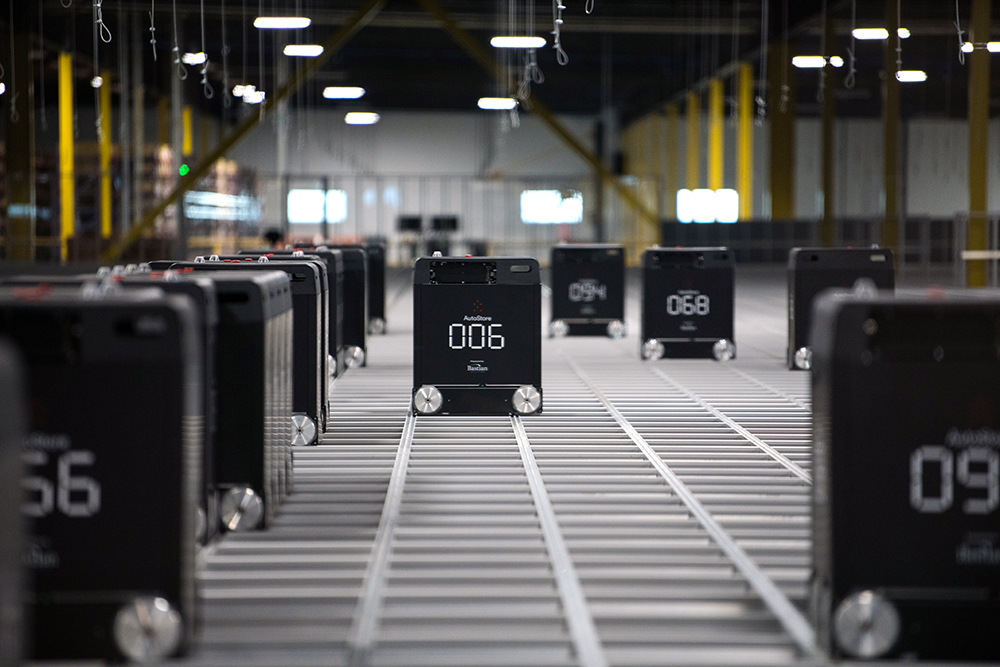
Using an AutoStore ASRS as a Manufacturing WIP Storage Buffer
Ahmed Arif | 21 October 2020
Traditionally, many manufacturing environments look to store work in progress (WIP) goods in high-density shelving or racking systems with varying degrees of automation, ranging on the low end from static pallet racks or shelving units, to the mid-range mobile racking solutions, up to the high-end automated stacker cranes (ASRS cranes).
With the advent of cube storage solutions, non-traditional automated storage and retrieval systems (ASRS) have become more prevalent. In certain applications, the cube storage solution can be denser (smaller facility footprint) and less expensive than traditional ASRS. For example, a recent Bastian Solutions analysis for a customer had the following requirements:
- Storage for 25,000 WIP goods (correlated to approx.12,000 totes for this industry)
- Ability to induct/retrieve to and from any storage location to a single operator area
- Throughput capacity of 120 moves per hour
The existing system was a seven-aisle, mini-load ASRS stacker crane with a robot-on-a-rail feeding system. It had reached end of life with high maintenance costs and frequent downtime. A like-for-like replacement cost of the system was estimated in excess of $4M and would additionally require a building expansion to allow for future capacity growth.
The same design specifications were met with a cube storage system for a 30% reduction in floorspace and 60% reduction in cost (not including the amount saved by avoiding a building expansion).
Cube storage ASRS systems use interlocking bins stacked inside an extruded aluminum grid with no dead space for aisles. A fleet of robots drive across tracks on top of the grid and work together to “dig” bins out of the system and deliver to operator ports. With orders sent to the system in advance, this type of ASRS is able to present WIP goods to operators (or upstream/downstream automation such as AGVs or conveyor) in a constant flow that far exceeds rates of traditional ASRS systems.
Due to the high flexibility of the layout in cube storage systems, Bastian Solutions was able to identify an unused, awkwardly-shaped area of the facility to maximize storage utilization of the space. The L-shaped storage area with pedestrian tunnel was able to accommodate all storage requirements with the additional benefits compared to a traditional ASRS crane solution.
The proposed cube-based automation system:
- Reduced capital expense by more than $2M
- Removed complex front-end transfer equipment (in this case, a robot-on-rail system)
- Exceeded required system throughput (a single AutoStore port frequently cycles more than 250 bins/hour, and sometimes more than 300 bins/hour)
- Eliminated dead space from aisles
- Offered simpler throughput expansion capability (a new grid-top robot can be added in less than five minutes)
Cube storage automation systems such as AutoStore are not always an appropriate solution, but data analysis on an operation’s order profile and volume can determine how effective it may or may not be in comparison to other available ASRS solutions. A key takeaway is to invest the time in this analysis period to select the right solution for your operation today and into the future.
As the Senior Director of Regional Office Solutions for Bastian Solutions, Ahmed and his teams are responsible for helping our customers achieve their goals in manufacturing, distribution, warehouse management and logistics. A graduate of Purdue University, Ahmed has been with Bastian Solutions for more than sixteen years in a variety of roles.
Comments
No comments have been posted to this Blog Post
Leave a Reply
Your email address will not be published.
Comment
Thank you for your comment.